Complex numbers extend mathematics beyond real numbers. They allow us to solve equations and problems that real numbers alone cannot.
In this blog, you will learn the definition of complex numbers, their properties, formulas, operations, and real-world applications.
By the end, you will clearly understand why complex numbers are important in maths, engineering, and science.
Let’s begin with the basics.
What Are Complex Numbers?
A complex number is a number that combines a real part and an imaginary part.
- It is written in the form: z = a + bi
Where:
- a = real part
- b = imaginary coefficient
- i = √(−1)
Example: 3 + 4i, −5 + 2i
Formulas of Complex Numbers
- z = a + bi
- |z| = √(a² + b²)
- Conjugate: z̅ = a − bi
- Argument: θ = tan⁻¹(b/a)
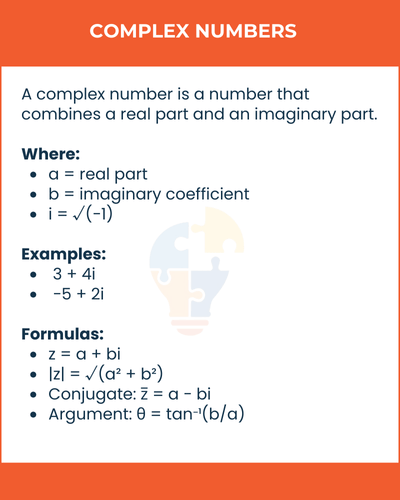
Absolute Value of a Complex Number
The absolute value (or modulus) of a complex number z = a + bi is:
|z| = √(a² + b²)
Example: For z = 3 + 4i,
|z| = √(3² + 4²) = √25 = 5
Algebraic Operations on Complex Numbers
1) Addition of Complex Numbers
Add real parts and imaginary parts separately.
(3 + 2i) + (5 + 4i)
= (3 + 5) + (2i + 4i)
= 8 + 6i
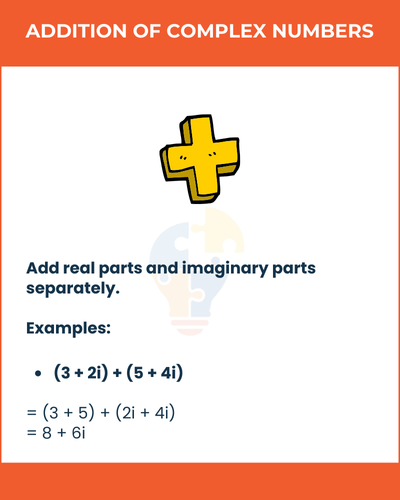
2) Subtraction of Complex Numbers
Subtract real and imaginary parts separately.
(7 + 5i) − (4 + 3i)
= 3 + 2i
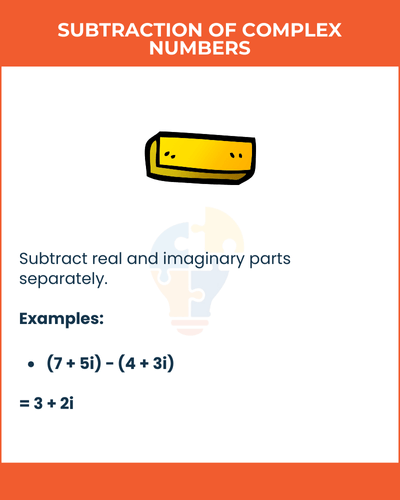
3) Multiplication of Complex Numbers
Multiply like binomials and replace i² with −1.
(2 + 3i)(4 + 5i)
= 8 + 10i + 12i + 15i²
= −7 + 22i
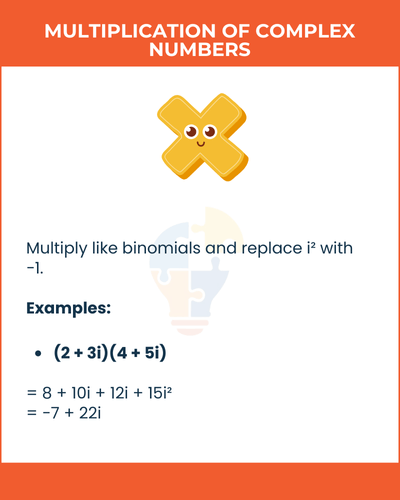
4) Division of Complex Numbers
Multiply numerator and denominator by conjugate of denominator.
(3 + 2i) ÷ (1 − i)
= (3 + 2i)(1 + i) ÷ (1 − i)(1 + i)
= (3 + 3i + 2i + 2i²) ÷ (1 + 1)
= (1 + 5i) ÷ 2
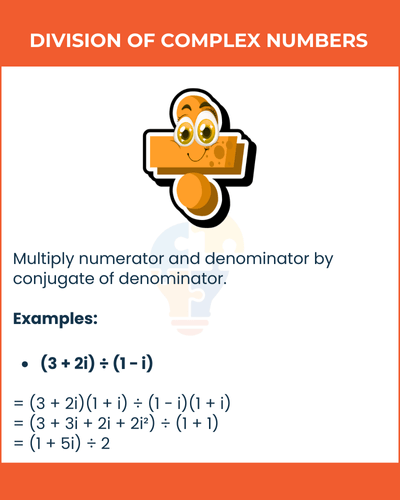
Power of Iota (i)
i follows a repeating cycle:
- i¹ = i
- i² = −1
- i³ = −i
- i⁴ = 1
- i⁵ = i (cycle repeats)
Identities of Complex Numbers
- z × z̅ = |z|²
- (a + bi)(a − bi) = a² + b²
- |z₁ × z₂| = |z₁| × |z₂|
- |z₁ ÷ z₂| = |z₁| ÷ |z₂|
Properties of Complex Numbers
1) Conjugate of a Complex Number
For z = a + bi, the conjugate is z̅ = a − bi.
Example: Conjugate of 5 + 3i is 5 − 3i.
2) Reciprocal of a Complex Number
1/z = z̅ ÷ |z|²
Example: 1/(3 + 4i) = (3 − 4i)/25
3) Equality of Complex Numbers
Two complex numbers are equal if both their real and imaginary parts are equal.
Example: 2 + 5i = 2 + 5i
4) Ordering of Complex Numbers
Unlike real numbers, complex numbers cannot be ordered on a single line. Instead, they are represented on a plane (Argand plane).
Argand Plane and Polar Representation
Complex numbers can be represented on the Argand plane.
- Horizontal axis = real part
- Vertical axis = imaginary part
Polar Form
z = r(cosθ + i sinθ)
Where:
- r = |z| = modulus
- θ = argument
Modulus and Conjugate
- Modulus (|z|): Distance from origin on the Argand plane.
- Conjugate (z̅): Mirror reflection of the number across the real axis.
Example: z = 3 + 4i
- |z| = 5
- z̅ = 3 − 4i
Complex Numbers Tips and Tricks
- Remember i² = −1 to simplify problems quickly.
- Use conjugates for dividing complex numbers.
- Visualize on the Argand plane for clarity.
- Use prime factorization when powers of i get large (since it repeats every 4 steps).
Conclusion
Complex numbers are numbers made of real and imaginary parts. They are written in the form a + bi, where i = √(−1).
They follow specific rules for addition, subtraction, multiplication, and division.
With properties like modulus, conjugate, and polar representation, complex numbers are widely used in mathematics, engineering, and physics.
Though they may seem abstract, complex numbers are powerful tools that simplify equations and explain real-world problems like waves, electricity, and quantum mechanics.
Read More What Are Composite Numbers? Types and Properties
FAQs
Q1. What are complex numbers?
Complex numbers are numbers with a real part and an imaginary part, written as a + bi.
Q2. What is the imaginary unit i?
i is defined as √(−1).
Q3. What is the modulus of 3 + 4i?
|z| = √(3² + 4²) = 5.
Q4. What is the conjugate of 5 + 2i?
The conjugate is 5 − 2i.
Q5. How do you add complex numbers?
Add real parts together and imaginary parts together.
Q6. What is the power cycle of i?
i¹ = i, i² = −1, i³ = −i, i⁴ = 1, then it repeats.
Q7. What is the polar form of a complex number?
z = r(cosθ + i sinθ), where r = modulus, θ = argument.
Q8. Can complex numbers be ordered like real numbers?
No, complex numbers cannot be ordered on a single line.
Q9. Where are complex numbers used?
They are used in physics, engineering, electronics, and wave analysis.
Q10. Who introduced complex numbers?
Complex numbers were introduced by mathematicians in the 16th century.

